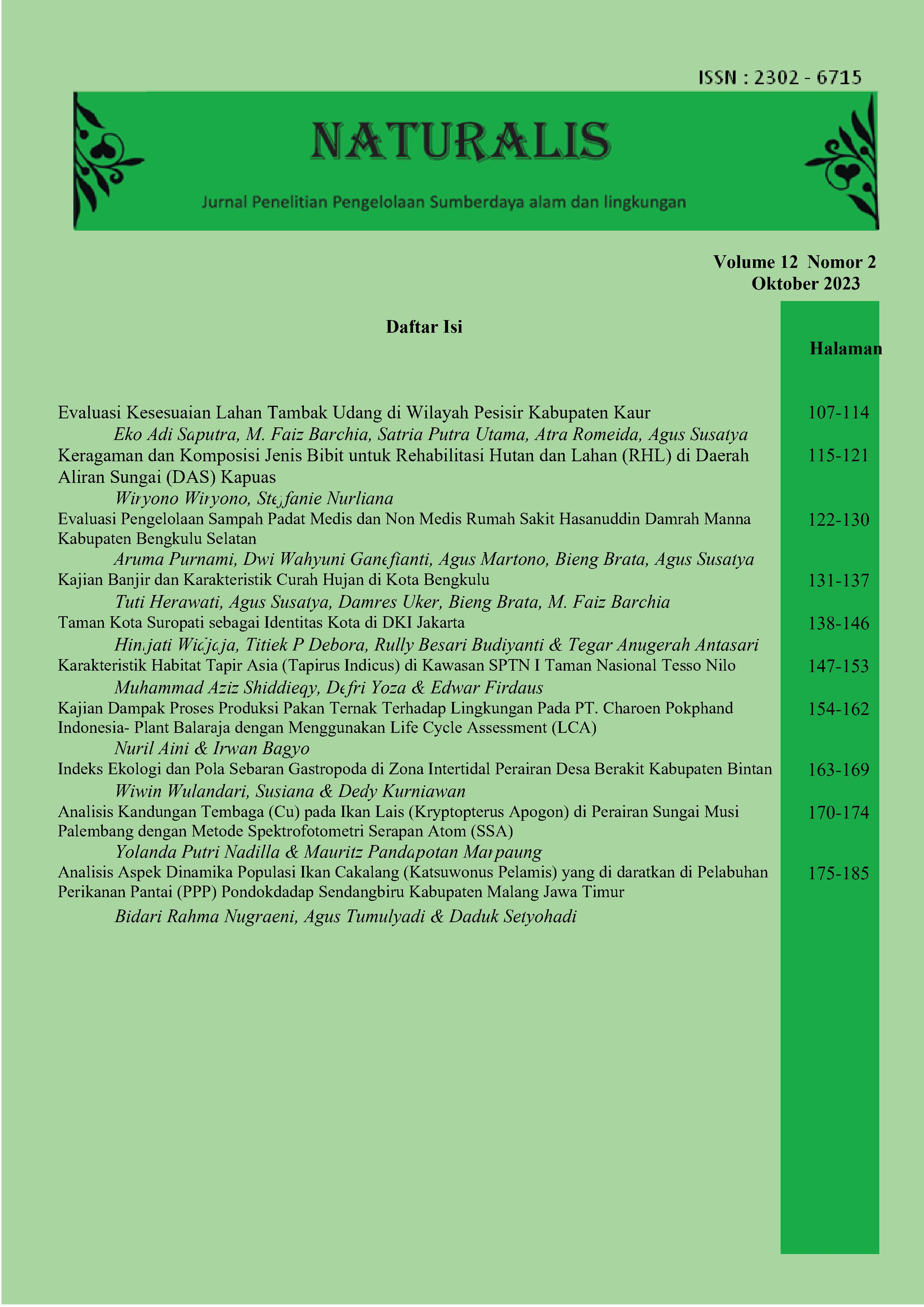Keragaman dan Komposisi Jenis Bibit untuk Rehabilitasi Hutan dan Lahan (RHL) di Daerah Aliran Sungai (DAS) Kapuas
Abstract
Indonesia has extensive degraded land to be rehabilitated. This study aimed to analyze the species diversity and composition of seedlings for land rehabilitation in Kapuas Watershed, the reasons for species selection, and the location of seedling plantation and to compare the species compostion of seedlings for rehabilitation of degraded lnad in Kapuas Watershed dan Serayu-Opak-Progo Watershed. Three-year (2015-2016-2017) data of seedlings were gathered through questionnaire to Kapuas Watershed Management Agency. The data were analyzed quantitatively using a statistical software called Past. The results showed that the species richness of seedlings ecah year ranged from 15-25 eitth a total of total species of 34, consisting of 24 native species and 10 introduced. The Simpson dominance index (D) was 0.19-0.93, Simpson diversity index (1-D) 0.07- 0.81, and Shannon diversity index (H’) 0.22-1.97. The selection of species was mostly determined by its high availability and most of the seedlings were planted in forest area. The composition of seedling species in Kapuas Watershed had low similarity with that of Serayu-Opak-Progo Watershed. The resulted vegetation would have moderately diverse species.
Full text article
References
Austin, K.G., A. Schwantes, Y. Gu, & P.S. Kasibhatla. 2019. What causes deforestation in Indonesia? Environ. Res. Lett. 14, 024007. https://doi.org/10.1088/1748-9326/aaf6db
BPS (Biro Pusat Statistik Indonesia). 2020. Statistics of timber culture establishment. BPS Indonesia.
CABI Digital Library. 2019. Hevea brasiliensis (rubber). https://www.cabidigitallibrary.org/doi/10.1079/cabicompendium.27999
Feintrenie, L., S. Schwarze & P. Levang. 2010. Are Local People Conservationists? Analysis of Transition Dynamics from Agroforests to Monoculture Plantations in Indonesia. Ecol. Soc. 15, art37. https://doi.org/10.5751/ES-03870-150437
Hammer, Ø., D.A.T. Harper & P.D. Ryan. 2001. PAST - PAlaeontological STatistics 31.
Hossain, A., T.J. Krupnik, J. Timsina, M.G. Mahboob, A.K. Chaki, A.K. et.al. 2020. Agricultural Land Degradation: Processes and Problems Undermining Future Food Security, in: Fahad, S., M. Hasanuzzaman, M. Alam, et al. (Eds.), Environment, Climate, Plant and Vegetation Growth. Springer International Publishing, Cham, pp. 17–61. https://doi.org/10.1007/978-3-030-49732-3_2
KemenLHK, 2021. Statistik 2020 Kementerian Lingkungan Hidup dan Kehutanan. Ministry of, Jakarta.
Maimunah, S., H. Mudzakir, M. Sopan, & J.H. Samek, J.H., 2020. Keanekaragaman Jenis Pohon Penyusun Arboretum Konservasi Hutan Hujan Tropis PT ASMIN BARA BRONANG Kabupaten Kapuas Kalimantan Tengah. J. Hutan Trop. 8, 274. https://doi.org/10.20527/jht.v8i3.9626
Munawar, A. & Wiryono. 2015. Serapan Karbon oleh Mangium dan Sengon Berumur Empat Tahun pada Lahan Pascatambang yang Sudah Direklamasi. J. Nat. Indones. 16, 42. https://doi.org/10.31258/jnat.16.1.42-47
POW. 2022. Plants of the Worlds online. https://powo.science.kew.org/.
Richardson, J.E., C.M. Costion & A.N. Muellner. 2012. The Malesian floristic interchange: plant migration patterns across Wallace’s Line, in: Biotic Evolution and Environmental Change in Southeast Asia. Cambridge University Press.
Society for Ecological Restoration International Science & Policy Working Group. 2004. The SER International Primer on Ecological Restoration.
Wahyudi, A, F.H. Susanty & N.S. Lestari. 2017. Vegetation Diversity at Burned Forest in Kutai National Park, East Kalimantan. J. Penelit. Ekosistem Dipterokarpa 3.
Wiryono, W., Lukman, A.H., Nurliana, S., 2022. The species diversity and composition of seedlings for degraded land rehabilitation in different phytogeographical regions in Indonesia. Biodiversitas J. Biol. Divers. 23. https://doi.org/10.13057/biodiv/d231130
Wiryono, W., Nurliana, S., 2022. The species diversity and composition of seedlings provided by the Serayu Opak Progo Watershed Management Center in 2015-2017. J. Glob. For. Environ. Sci. 2, 1–9.
Wiryono, W., V.N.U. Puteri & G. Senoaji. 2016. The diversity of plant species, the types of plant uses and the estimate of carbon stock in agroforestry system in Harapan Makmur Village, Bengkulu, Indonesia. Biodiversitas J. Biol. Divers. 17. https://doi.org/10.13057/biodiv/d170136
Wiryono & A. B. Siahaan, 2013. Species composition of understory vegetation in coal mined land in Central Bengkulu, Indonesia. Biodiversitas J. Biol. Divers. 14. https://doi.org/10.13057/biodiv/d140105
Peraturan Pemerintah Republik Indonesia Nomor 76 Tahun 2008 Tentang Rehabilitasi Dan Reklamasi Hutan
Authors
Copyright (c) 2023 Wiryono Wiryono, Steffanie Nurliana

This work is licensed under a Creative Commons Attribution-ShareAlike 4.0 International License.
An author who publishes in Naturalis agrees to the following terms:
Author retains the copyright and grants the journal the right of first publication of the work simultaneously licensed under the Creative Commons Attribution-ShareAlike 4.0 License that allows others to share the work with an acknowledgement of the work's authorship and initial publication in this journal
The author is able to enter into separate, additional contractual arrangements for the non-exclusive distribution of the journal's published version of the work (e.g., post it to an institutional repository or publish it in a book) with the acknowledgement of its initial publication in this journal. The author is permitted and encouraged to post his/her work online (e.g., in institutional repositories or on their website) prior to and during the submission process, as it can lead to productive exchanges, as well as earlier and greater citation of the published work (See The Effect of Open Access).
Submission of a manuscript implies that the submitted work has not been published before (except as part of a thesis or report, or abstract); that it is not under consideration for publication elsewhere; that its publication has been approved by all co-authors. If and when the manuscript is accepted for publication, the author(s) still hold the copyright and retain publishing rights without restrictions. Authors or others are allowed to multiply an article as long as not for commercial purposes. For the new invention, authors are suggested to manage its patent before published. The license type is CC-BY-SA 4.0.
Naturalis is licensed under a Creative Commons Attribution-ShareAlike 4.0 International License.

